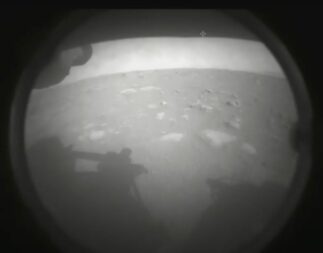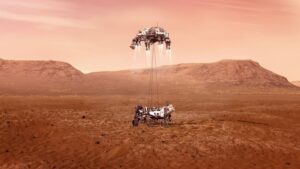Eastern, seven minutes after the rover, encapsulated within a heatshield and backshell, entered the Martian atmosphere. The entry, descent and landing appeared to go according to plan, punctuated with a “Touchdown confirmed!” call in mission control at the Jet Propulsion Laboratory.
“This landing is one of those pivotal moments for NASA, the United States, and space exploration globally – when we know we are on the cusp of discovery and sharpening our pencils, so to speak, to rewrite the textbooks,” Steve Jurczyk, NASA’s acting administrator, said in an agency statement shortly after the successful landing. “The Mars 2020 Perseverance mission embodies our nation’s spirit of persevering even in the most challenging of situations, inspiring, and advancing science and exploration.”
The $2.7 billion mission, known as Mars 2020, launched July 30 of last year on a United Launch Alliance Atlas 5. Now on the surface, it will operate for at least one Martian year — nearly two Earth years — and likely for far longer, barring any technical issues.
Perseverance is NASA’s fifth Mars rover, dating back to the Sojourner rover flown on the Mars Pathfinder mission that landed in 1997, and is by far the most sophisticated. While similar to size to the Curiosity rover that has been on Mars since 2012, the 1,025-kilogram Perseverance is about 100 kilograms heavier and has a payload of science instruments and technology demonstrations 50% larger.

Most of that payload will be devoted to studies of the landing site and surrounding region, looking for evidence of past Martian life. Scientists will also use the rover’s instruments to characterize the planet’s geology and climate.
A key aspect of that science mission will be to collect samples of a wide range of Martian rocks, including those that scientists believe contain biosignatures, or evidence of past life. Perseverance will cache those samples, either in selected locations on the surface or on the rover itself, to be returned to Earth by two later missions that will launch no earlier than 2026 as part of the broader Mars Sample Return campaign NASA is conducting in cooperation with the European Space Agency.
Scientists hope that either the instruments on Perseverance, or the samples brought back to Earth for analysis in terrestrial labs in the 2030s, will turn up evidence of past life. But they also acknowledge that the samples might find no evidence of such life. If that happens, “it would suggest that not all habitable environments that exist are inhabited,” said Ken Farley, Mars 2020 project scientist, at a Feb. 17 briefing. “We just can’t assume that everywhere that is habitable has had life originate and thrive in it.”
“I don’t necessarily think it would be the end of exploration on Mars and looking for life on Mars,” added Lori Glaze, director of NASA’s planetary science division. “We would need to keep looking, and look harder, maybe in other places.”
Besides looking for evidence of past life, Perseverance is also a step toward future life in the form of human missions. One payload on the rover, called MOXIE, will test the ability to convert carbon dioxide in the atmosphere into oxygen for life support and propellant. The rover will also deploy a small helicopter, called Ingenuity, that will attempt the first powered flight in the Martian atmosphere. Such vehicles could serve as scouts for astronauts on future missions.
“This rover has a substantial amount of feed-forward technology on it,” said Matt Wallace, deputy project manager for Mars 2020, at a Feb. 17 webinar by the National Academies’ Space Studies Board. He worked on NASA’s four previous Mars rovers, from Sojourner to Curiosity. “This is really the first one that I think of as a human precursor mission.”



